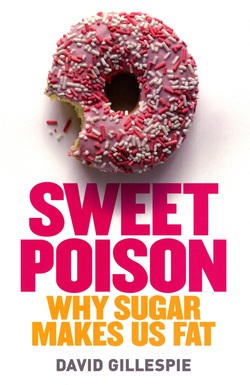 Sweet Poison: Why Sugar Makes Us Fat by David Gillespie, Penguin Books, 2008. Link is to the book’s page on the author’s website. Some parts of this website are subscription only.
Sweet Poison: Why Sugar Makes Us Fat by David Gillespie, Penguin Books, 2008. Link is to the book’s page on the author’s website. Some parts of this website are subscription only.
You’ll find quite a few books about food and nutrition as this book blog continues. (I’m reading a book titled The Big Fat Surprise: Why Butter, Meat & Cheese Belong in a Healthy Diet; it should show up soon.) David Gillespie is the most accessible writer I’ve found on the subject of the evils of sugar. Robert Lustig’s Fat Chance and Gary Taubes’ Why We Get Fat: and What to Do About It are both good resources but very dense. You have to be pretty interested in the subject already in order to be motivated to plow through them. Gillespie, on the other hand, is funny, smart, and brief, and he plentifully illustrates his ideas from his own experience. I have to admit that I did a little skipping in the chapter “Biochemistry 101,” but he does an admirable job of explaining the actual processes by which our bodies transform food into energy.
Gillespie makes a compelling case for the idea that the real villain in our modernized, industrialized diet is fructose, or fruit sugar, which makes up approximately half of the major sweeteners in use today: sucrose, or table sugar (from sugar cane or sugar beets, and don’t think that the “raw” or “unrefined” versions are any healthier than the plain old refined white stuff), high-fructose corn syrup, regular corn syrup, honey, agave nectar, maple syrup, etc. It seems confusing that fructose would be bad for you, since fruit is good for you. But you can only eat so much fruit at a time. Whole fruit contains fiber, which is filling but indigestible. In order to get the same amount of fructose you’d find in a large soft drink (in Australia, where Gillespie lives, that’s about 20 ounces; 32-ounce drinks are more the norm in America) you’d have to eat four or five large apples. You’d never do that unless you were marooned in an orchard, but you can suck down that soft drink or juice (yes, juice) and still have plenty of room for the rest of your meal because the body doesn’t “see” the calories from fructose. It’s pretty fascinating!
Gillespie’s book has sold very well, and he’s now pretty much developed his own industry: other books, including a cookbook, and websites to which you have to subscribe. He inspired the recent American book The Year of No Sugar, which has been getting a fair amount of buzz. (I’d stick with Gillespie if I were you.) I wasn’t able to find Sweet Poison in the library and so actually broke down and bought a copy. I’d suggest you do the same. I may even buy his no-sugar cookbook; I have a 50-lb. order of dextrose on the way, and I need to know what to do with it. If you keep up with the “food” section of this website you’ll probably see some dextrose-containing recipes soon. In the meantime, put down that soda and read this book!